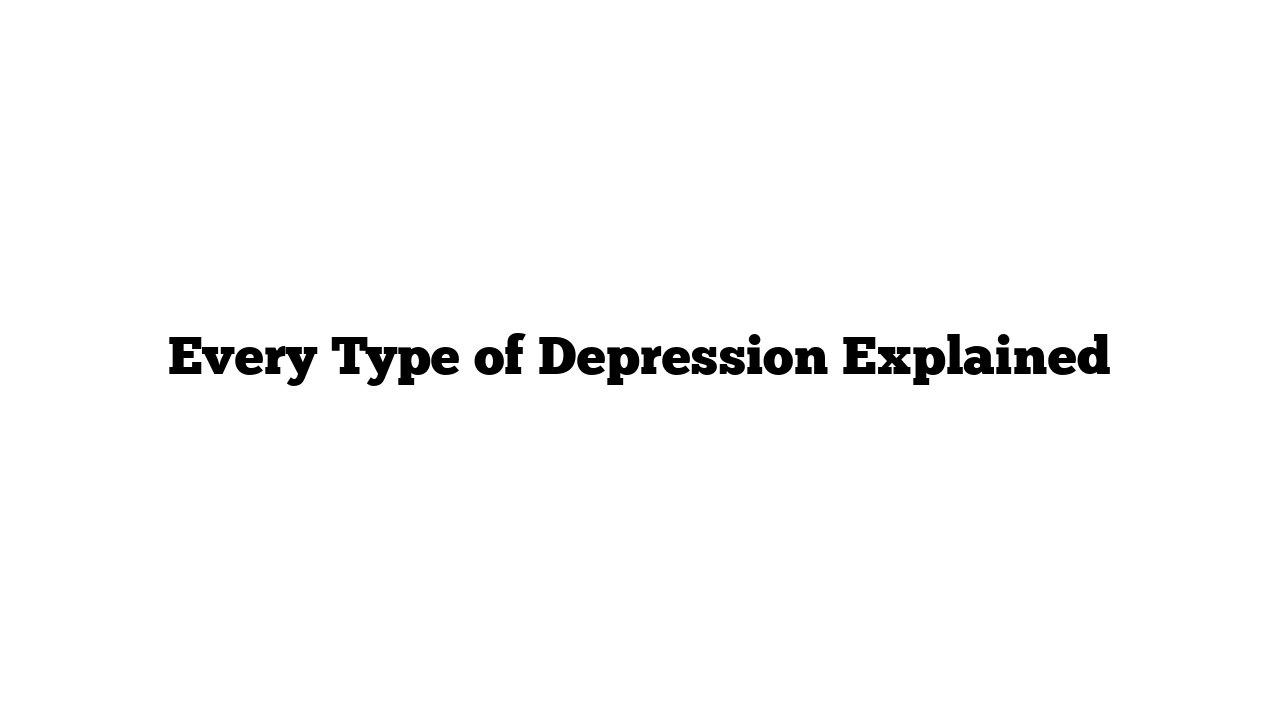Major Depression
Major depression is a serious mental health issue characterized by a persistent feeling of sadness or a lack of interest in activities you once enjoyed. It can stem from various factors, including biological, cognitive, and social influences. Studies suggest that these factors can significantly impact how the brain functions.
Navigating this mental health challenge can feel like dealing with a whirlwind of emotions. You might feel as grumpy as a cat during its morning routine, experience low self-worth, and struggle to see anything positive. Other common symptoms include restlessness, difficulty concentrating, irritability with loved ones, a desire for solitude, excessive sleeping, fatigue, thoughts of not wanting to live, and noticeable weight changes.
For some, major depression can be recurrent, with episodes occurring monthly, yearly, or multiple times throughout life. People who experience recurrent episodes are sometimes diagnosed with unipolar depression, as they only go through periods of low or depressed mood.
Dysthymia
Dysthymia, or persistent depressive disorder, lasts for two years or more. While it may not feel as intense as major depression, it can still strain relationships and make daily tasks challenging. Symptoms include prolonged sadness for no apparent reason, low self-esteem, fluctuating appetite, changes in sleep patterns, and memory issues. People with dysthymia may find their interests shift rapidly, finding themselves enthusiastic about one thing one minute and indifferent the next. Over time, those experiencing this long-lasting depression might start to accept it as the norm.
Manic Depression
Manic depression, also known as bipolar disorder, features alternating episodes of intense happiness (mania or hypomania) and deep depression. Hypomania is a milder form of mania. During a manic episode, you might experience increased energy levels, a decreased need for sleep, irritability, rapid thoughts and speech, grandiosity, and risky behaviors, along with an overwhelming sense of elation.
To receive a diagnosis, a doctor must confirm that you’ve had a manic episode lasting at least seven days (or a shorter duration if hospitalization is required). Depressive episodes can occur before or after manic episodes, mirroring symptoms of major depression.
Postpartum Depression
Postpartum depression (PPD) often affects new mothers, sometimes referred to as the “baby blues.” While it’s normal for many to experience temporary sadness after childbirth due to hormonal changes, about one in seven women may experience more intense feelings of sadness lasting for several weeks. Symptoms include deep sadness, social withdrawal, disinterest in activities, and changes in sleeping and eating habits. If you notice persistent sadness, fatigue, irritability, or racing thoughts after giving birth, it’s crucial to seek help from a healthcare provider.
Seasonal Affective Disorder
Seasonal affective disorder (SAD) is linked to changes in seasons, with symptoms typically starting in fall and lasting through winter, although it can also occur in spring or summer. Common symptoms include sadness, fatigue, loss of interest, heaviness in limbs, cravings for carbohydrates, weight gain, and relationship difficulties. Treatment may involve medication, therapy, light therapy, or a combination of these approaches. Talking to a therapist can help identify negative thought patterns, teach coping strategies, and introduce relaxation techniques to regain lost energy.
Psychotic Depression
Psychotic depression occurs in about 20% of those with depression. When someone has major depressive disorder with psychotic features, they experience a combination of depression and psychosis. Psychosis can involve confused thinking, delusions, or hallucinations. Early signs include suspicion of others, social withdrawal, intense and inappropriate emotions, and difficulty with personal hygiene and daily responsibilities. To be diagnosed, there must be a depressive episode lasting two weeks or more, accompanied by delusions or hallucinations.
Premenstrual Dysphoric Disorder
Premenstrual dysphoric disorder (PMDD) is a severe form of premenstrual syndrome (PMS) linked to hormonal changes, affecting about 5% of women. Symptoms typically occur in most menstrual cycles over a year and can disrupt work and social life. Common symptoms include mood swings, anxiety, irritability, and physical symptoms. Doctors may recommend antidepressants or other treatments to alleviate symptoms.
Atypical Depression
Atypical depression is a type of major depressive disorder characterized by temporary improvement in mood following positive experiences. Despite its name, atypical depression is quite common and equally serious as other forms. Symptoms may include increased appetite, weight gain, oversleeping, feeling heavy in the arms or legs, sensitivity to rejection, and persistent aches and pains.
Situational Depression
Also known as adjustment disorder with depressed mood, situational depression arises from specific events or circumstances, such as the loss of a loved one, serious illness, divorce, or unemployment. While it’s normal to feel sad or anxious in response to life events, situational depression occurs when these feelings become overwhelming and interfere with daily life. Symptoms often start within three months of the triggering event and can include excessive crying, hopelessness, anxiety, changes in appetite, sleep disturbances, low energy, and social withdrawal.
Disruptive Mood Dysregulation Disorder
Disruptive mood dysregulation disorder (DMDD) affects children and teenagers, characterized by severe temper outbursts, irritability, and anger that go beyond typical moodiness. Kids with DMDD may struggle at home, school, and in social situations, potentially needing medical intervention or counseling. As children with DMDD mature, their symptoms may change; they might experience fewer tantrums but develop anxiety or sadness. Early diagnosis and treatment are essential for managing DMDD and supporting healthy relationships.
This overview aims to provide a clear understanding of each type of depression, using simple language while maintaining a professional tone. Let me know if you would like any adjustments or additional sections!
